소개
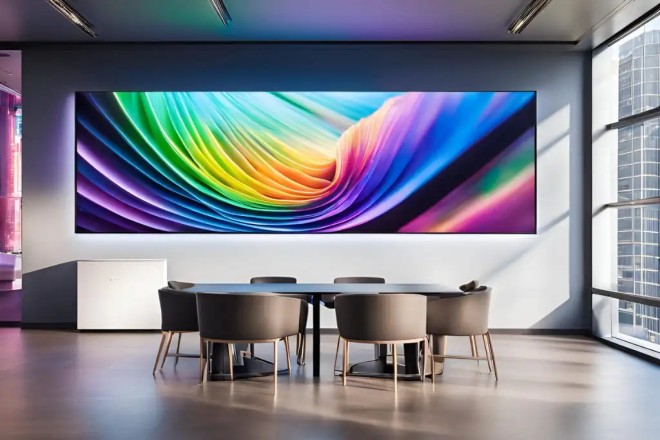
In modern display technology, customized 작은 피치 LED 스크린 have become the first choice for commercial advertising, public displays, conference rooms, etc., with their excellent display effects and flexible splicing.
Its tiny dot pitch brings nearly seamless vision and greatly improves image clarity. However, splicing technology is still unfamiliar to non-professionals.
This article reveals the principle, implementation method, and application case of seamless splicing technology for customized small-pitch LED screens, provides a comprehensive and in-depth understanding, and stimulates the desire to explore.
1. Advantages of Customized small-pitch LED displays
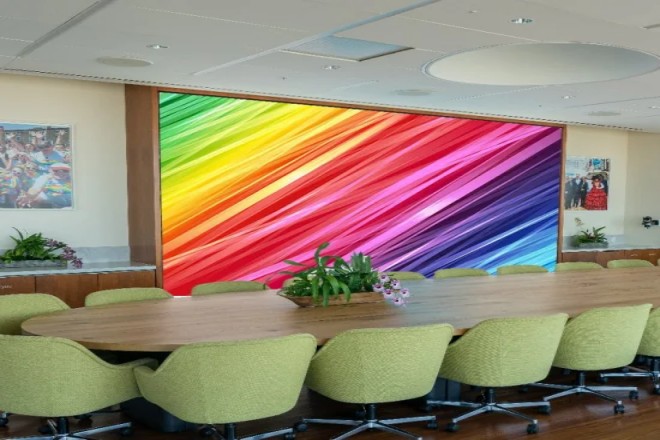
When we talk about Customized small-pitch LED displays, we must first clarify its definition. Simply put, a Customized small-pitch LED display is an LED display device with a dot pitch of less than 3 mm.
The “dot pitch” here refers to the distance between two adjacent LED lamp beads on the screen. Because this distance is very small, the Customized small-pitch LED display can present extremely high resolution and delicate display effects.
1.1). Advantages
- Seamless splicing, unified vision:
Imagine if you are standing in front of a huge display screen, and the screen is made up of multiple small pieces, but you can’t see any traces of splicing; this is the charm of the seamless splicing technology of Customized small-pitch LED displays.
It uses advanced splicing and calibration technology to enable multiple screens to achieve perfect integration when spliced, and the audience can hardly perceive any splicing gaps, thus ensuring the integrity of the image and visual continuity.
- Intelligent 명도 adjustment strong adaptability:
The Customized small-pitch LED display screen is not only high in brightness but also has an intelligent adjustment function.
It can automatically adjust its own brightness level according to the brightness of the surrounding environment to ensure that a clear and bright image can be presented under various lighting conditions.
This automatic adjustment function not only improves the viewing comfort but also reduces energy consumption, making it more environmentally friendly and energy-saving.
- High grayscale level and rich colors:
The grayscale level is an important indicator for measuring the color performance of the display screen. The Customized small-pitch LED display screen has a higher grayscale level, which means that it can present more color levels and details.
This makes the image more delicate and the color richer, and the audience can feel a more real and vivid visual effect.
- High contrast and 재생률, stable picture:
Contrast and refresh rate are key factors affecting image quality.
The Customized small-pitch LED display screen has the characteristics of high contrast and high refresh rate, which ensures that both the bright and dark parts of the image can be accurately presented, while avoiding the occurrence of problems such as image flickering and ripples.
When watching, the audience can feel that the picture is more stable and smooth, which improves the overall viewing experience.
- High color reproduction, real and natural:
Color reproduction is one of the important indicators to measure the performance of the display. The Customized small-pitch LED display adopts point-by-point correction technology to accurately adjust the luminous intensity and color of each LED lamp bead to ensure the color consistency of the entire screen.
This technology enables the display to restore more natural and real colors, making the audience feel as if they are in a real scene, enhancing the immersion and sense of substitution of the viewing.
2. What are the core elements of splicing technology?
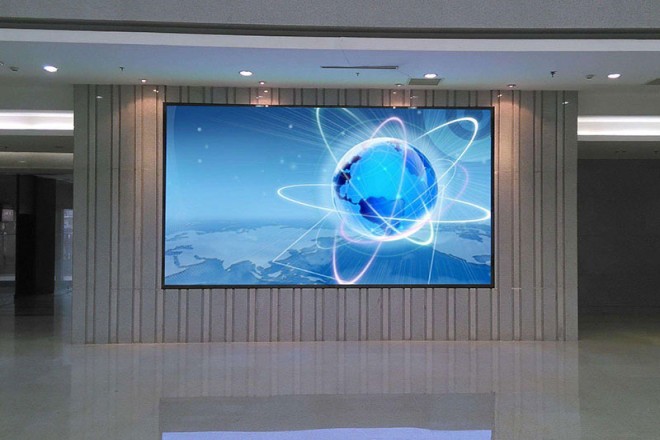
The splicing technology of Customized small-pitch LED displays is the key to achieving seamless connection of multiple display screens and presenting a unified image.
The core elements of this technology mainly include signal output synchronization, graphics processing algorithms, and output of non-standard resolutions. The following will analyze these core elements in detail:
2.1). Signal output synchronization:
- 중요성:
When splicing multiple Customized small-pitch LED displays, it is very important to ensure the synchronization of all output signals.
If the signal output is not synchronized, the splicing may cause screen tearing, dislocation, or asynchrony, especially when playing high-speed motion images. This asynchrony phenomenon will be particularly obvious.
- Implementation:
In order to ensure the synchronous output of the signal, the splicer needs to adopt advanced synchronization control technology.
For example, a signal synchronizer or synchronization card is used to ensure the synchronous output of all DVI signals.
At the same time, the signal transmission path needs to be accurately calibrated to reduce delays and distortions during signal transmission.
2.2). Graphics processing algorithm:
- 중요성:
As the pixel pitch of LED displays decreases and the viewing distance shortens, image processing algorithms play an increasingly important role in maintaining image clarity and fineness.
- Implementation:
High-end image processing chips or complex FPGA graphics processing algorithms are the key to improving image processing capabilities.
These algorithms can optimize the edge smoothness, brightness uniformity, and color reproduction of the image, ensuring that the image remains clear and fine after scaling.
At the same time, these algorithms can also support the conversion of multiple image formats and resolutions to meet the needs of different application scenarios.
2.3). Output of non-standard resolution:
- 중요성:
Since the physical resolution of LED displays may be irregular, and the size and resolution of each display unit are fixed, it is often impossible to obtain a standard resolution when splicing the entire display.
This requires the splicer to support the output of non-standard resolutions and adapt to the needs of different splicing methods and resource allocation.
- 구현 방법:
The splicer needs to have a flexible resolution setting function and be able to quickly adjust the output resolution according to different splicing methods and display requirements.
At the same time, it is also necessary to support the input and output of custom resolutions to meet the needs of special application scenarios. For example, when splicing a super-large LED display, it may be necessary to splice multiple independent display areas.
At this time, the splicer needs to support multiple inputs and outputs with different resolutions.
3. The role and classification of splicers
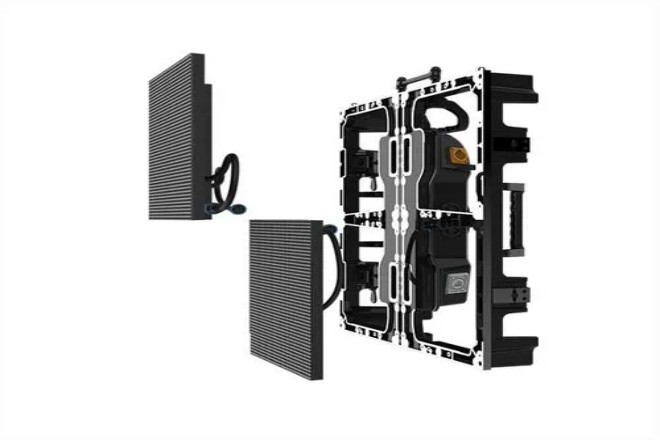
3.1). The role of splicers
Splicers, this device that sounds a bit professional, actually plays a super important role in large-screen display systems. Imagine that when you stand in front of a huge LED screen, you see a complete, continuous, seamless image, all of which is inseparable from the credit of the splicer.
- Multi-channel DVI signal output:
The splicer is like a signal converter, which receives input signals from various signal sources (such as computers, cameras, DVDs, etc.) and then converts these signals into multi-channel DVI signal outputs. Each DVI signal can drive a display screen so that multiple displays can display the same picture together.
- Seamless splicing:
The most powerful thing about the splicer is that it can make multiple displays look like a complete screen when spliced together.
This is thanks to the image processing technology inside the splicer, which will fine-tune the image on each display screen to ensure that there are no problems such as image tearing, misalignment or black edges at the splicing.
- Adapt to ultra-large-scale display:
The splicer can not only splice several displays but also expand according to the need to splice dozens, hundreds, or even more displays. This is very convenient for places that require real-time monitoring and management (such as control centers and data centers).
3.2). Classification of splicers
Splicers can be divided into several categories according to their internal architecture and technical characteristics. Each category has its own characteristics and applicable scenarios. Let’s take a look at them one by one!
- Embedded pure hardware architecture:
This splicer is like a special hardware device with a relatively simple structure and is not prone to failure.
It has a special acquisition board and output board inside that can receive and output multiple signals. Moreover, these boards are hot-swappable, so if they are broken, they can be directly replaced with new ones, which is very convenient.
The embedded pure hardware architecture splicer also uses backplane switching technology and output board unified clock technology to ensure the synchronization of multi-channel signal output. In this way, even if many display screens are spliced, there will be no problem with asynchronous pictures.
- PCI-E bus architecture:
The PCI-E bus architecture splicer uses advanced PCI Express technology, and the data transmission speed is very fast. It is also equipped with a high-performance CPU and large-capacity memory, which can directly run various applications.
More importantly, the PCI-E bus architecture splicer is also equipped with multiple high-performance graphics output cards, each of which has ultra-high internal bandwidth and video memory. In this way, it can handle more complex and more sophisticated images.
- Distributed network architecture:
The distributed network architecture splicer adopts a node-type hardware structure, and each input and output node is independent. They are connected to the central switch through twisted pair cables for data exchange and transmission.
The core of this architecture is a set of advanced video encoding and decoding technologies that can support input and output of multiple signal formats. Moreover, since each node is independent, the scalability and stability of the system are very high.
Distributed network architecture splicers are also very suitable for centralized management across regions and networks. For example, you can control display screens across the country in one place, which is very convenient.
- Hybrid architecture:
Hybrid architecture splicers are formed by combining two or more of the above three architectures. For example, some splicers may combine the advantages of PCI-E bus architecture and pure hardware embedded architecture, which not only ensures the stability of the system but also improves performance.
Hybrid architecture splicers can be flexibly configured and optimized according to actual needs to meet the needs of various complex scenarios.
4. Splicing cases of Customized small-pitch LED display screens
Regarding the splicing cases of Customized small-pitch LED display screens, the following are specific applications in the celebration of the 40th anniversary of the establishment of the Shenzhen Special Economic Zone and the conference hall of Tencent Binhai Building:
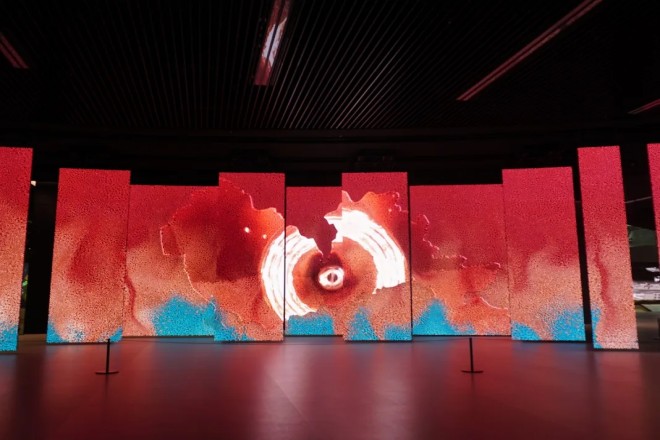
1). Celebration of the 40th Anniversary of the Establishment of the Shenzhen Special Economic Zone
At the celebration of the 40th anniversary of the establishment of the Shenzhen Special Economic Zone, the splicing technology of Customized small-pitch LED display screens provided the conference with stable and high-definition display effects.
Although the details of the specific splicing cases may vary due to factors such as venues and equipment suppliers, the splicing technology of Customized small-pitch LED display screens undoubtedly played an important role in the conference.
By splicing multiple customized small-pitch LED screens, the conference site was able to present a huge, continuous, seamless image, bringing a shocking visual effect to the audience. This splicing technology not only ensures the stability and clarity of the picture but also enhances the overall atmosphere and viewing experience of the conference.
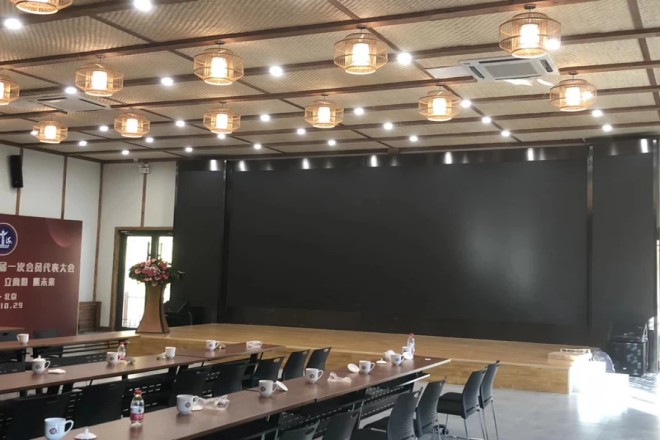
2). Tencent Binhai Building Conference Hall
In the multifunctional conference hall of the Tencent Binhai Building, the splicing technology of customized small-pitch LED screens has also been brilliantly applied. The multifunctional conference hall on the 48th floor of the Tencent Binhai Building uses an ultra-high-definition PH0.8mm Customized small-pitch LED display system.
The system achieves a display effect of ultra-4K resolution through seamless splicing technology. The entire display system not only has delicate pictures and bright colors but also can perfectly present various dynamic images and static pictures.
In addition, the system also supports remote control, timer switch, brightness adjustment, and other functions, which improve the convenience of use and management efficiency.
In the case of the conference hall of Tencent Binhai Building, the splicing technology of customized small-pitch LED screens not only meets the needs of high-end commercial display and conference but also highlights the sense of technology and intelligence of Tencent enterprises.
By splicing multiple Customized small-pitch LED displays, the conference hall can present a huge, seamless, high-definition display screen, bringing an excellent visual experience to the participants.
결론
The seamless splicing technology of Customized small-pitch LED displays not only improves the display effect but also provides more possibilities for various high-end application scenarios.
With the continuous advancement of technology, we have reason to believe that Customized small-pitch LED displays will play a more important role in the future display technology field.
마지막으로 LED 디스플레이에 대해 더 알고 싶으시다면, 우리에게 연락해주세요.
